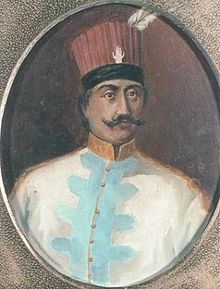Lambros Katsonis
Lambros Katsonis | |
|---|---|
 Portrait of Lambros Katsonis | |
| Native name | Λάμπρος Κατσώνης |
| Born | 1752 Livadeia, Eyalet of the Archipelago, Ottoman Empire (now Greece) |
| Died | 1805 Livadiya, Crimea, Russian Empire (now Russia) |
| Allegiance | |
| Service/ | |
| Rank | Colonel |
| Battles/wars | Russo-Turkish War (1768–1774)
|
| Awards | |
| Spouse(s) | Maria Sophianou (Angelina) |
| Children | 4, including Lykourgos and Alexandros |
| Relations | Odysseas Androutsos (godson) |
| Signature | |
Lambros Katsonis (
Early life
Lambros Katsonis was born in 1752 at
Three years later, he went to
Privateer activity
1788
When the

1789
His 1789 campaign was even more successful: he gathered a fleet of 17 vessels with 500 guns, and captured
On 3 June 1788, he defeated an Ottoman squadron of 11 or 14 ships, including two ships of the line and three frigates, in the strait between
1790
In 1790, Katsonis conceived his most ambitious plan yet. Taking on board the klepht chieftain Andreas Androutsos and his 800 men, he raided Turkish shipping in the Aegean, advancing up to Tenedos, blocking the entrance to the Dardanelles and hoping to confront an Ottoman fleet.[5][6] The Ottoman government reacted by calling on the aid of the North African fleets, and Katsonis was caught off guard, with his fleet dispersed. He was caught off Andros with only nine vessels between an Ottoman and an Algerian fleet, and defeated in a two-day battle.[5][7]
With the remaining ships Katsonis fled to the Ionian island of
1791–1792
Katsonis and his fleet remained active in the Aegean and continued to score successes against Ottoman shipping. By the summer of 1791, Katsonis disposed of 21 ships.
Marriage and children

His wife was known as Angelina in Russia, but her real name was Maria Sophianou. He had three sons and possibly one daughter. His first son was killed by the Turks when he was still infant, in the Greek island of
Legacy
The
took place. This is where he was assassinated in 1805.The Hellenic Navy has named four of its ships after Katsonis.
References
- ^ a b c Panos Stamou (c. 2007). Προσέγγιση ιστορικής προσωπικότητας μέσα από Αρχειακές πηγές: Περίπτωση Λάμπρου Κατσώνη [Approaching the historic person through archival sources: The case of Lampros Katsonis] (DOC) (in Greek). Hellenic Cultural Center (Moscow). p. 6.
- ^ a b c d e f g h Aspreas 1929, p. 103.
- ^ Aspreas 1929, pp. 103–104.
- ^ Pryakhin 2004, pp. 41–42.
- ^ a b c d e f Aspreas 1929, p. 104.
- ^ Pryakhin 2004, p. 43.
- ^ Pryakhin 2004, pp. 44–45.
- ^ Pryakhin 2004, p. 46.
- ^ Pryakhin 2004, pp. 46–47.
- ^ Pryakhin 2004, pp. 47–58.
- ^ Vakalopoulos 1975, pp. 92–93.
- ^ Pryakhin 2004, p. 58.
- ^ Vakalopoulos 1975, pp. 93–95.
- ^ Pryakhin 2004, pp. 59ff.
Sources
- Aspreas, G. (1929). "Κατσώνης Λάμπρος". Μεγάλη Στρατιωτικὴ καὶ Ναυτικὴ Ἐγκυκλοπαιδεία. Tόμος Τέταρτος: Καβάδης–Μωριάς [Great Military and Naval Encyclopaedia. Volume IV: Kavadh–Morea] (in Greek). Athens: Ἔκδοσις Μεγάλης Στρατιωτικῆς καὶ Ναυτικῆς Ἐγκυκλοπαιδείας. pp. 103–104. OCLC 31255024.
- ISBN 0520023420.
- Pryakhin, Yuri D. (2004). Ламброс Кацонис в истории Греции и России [Lambros Katsonis in the history of Greece and Russia] (in Russian). St. Petersburg: Aletheia. ISBN 5893297318.
- ISBN 978-960-213-100-8.

